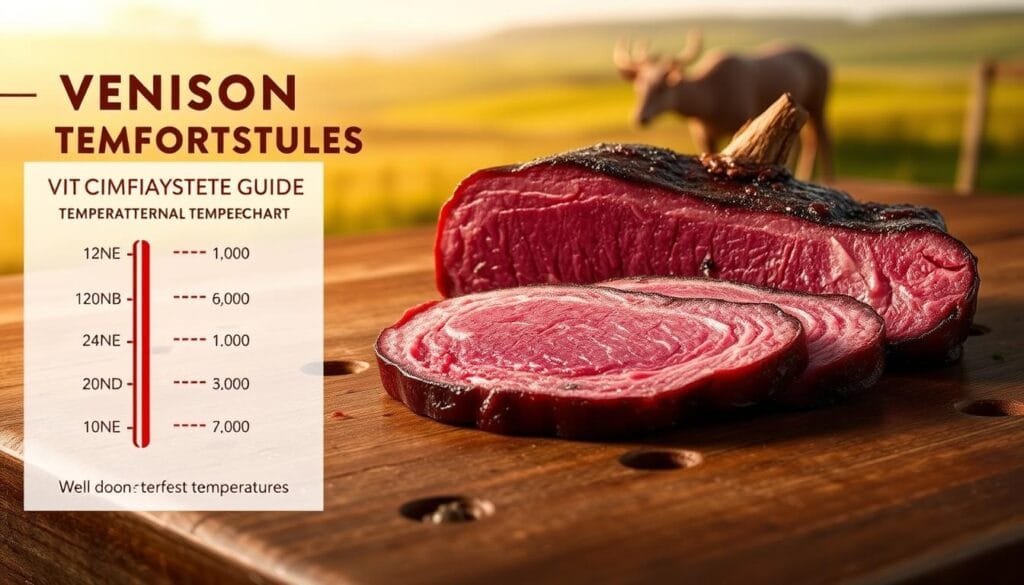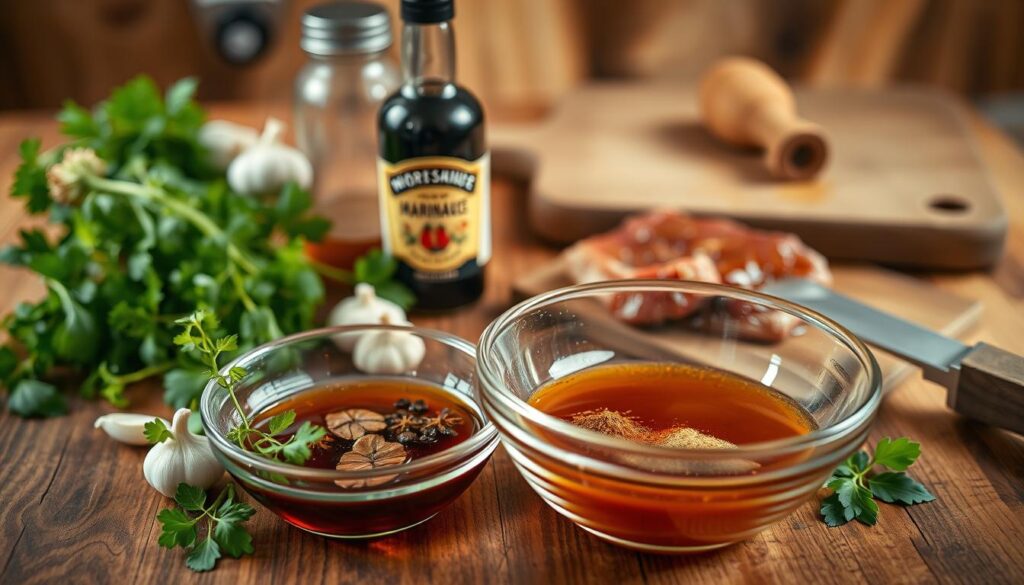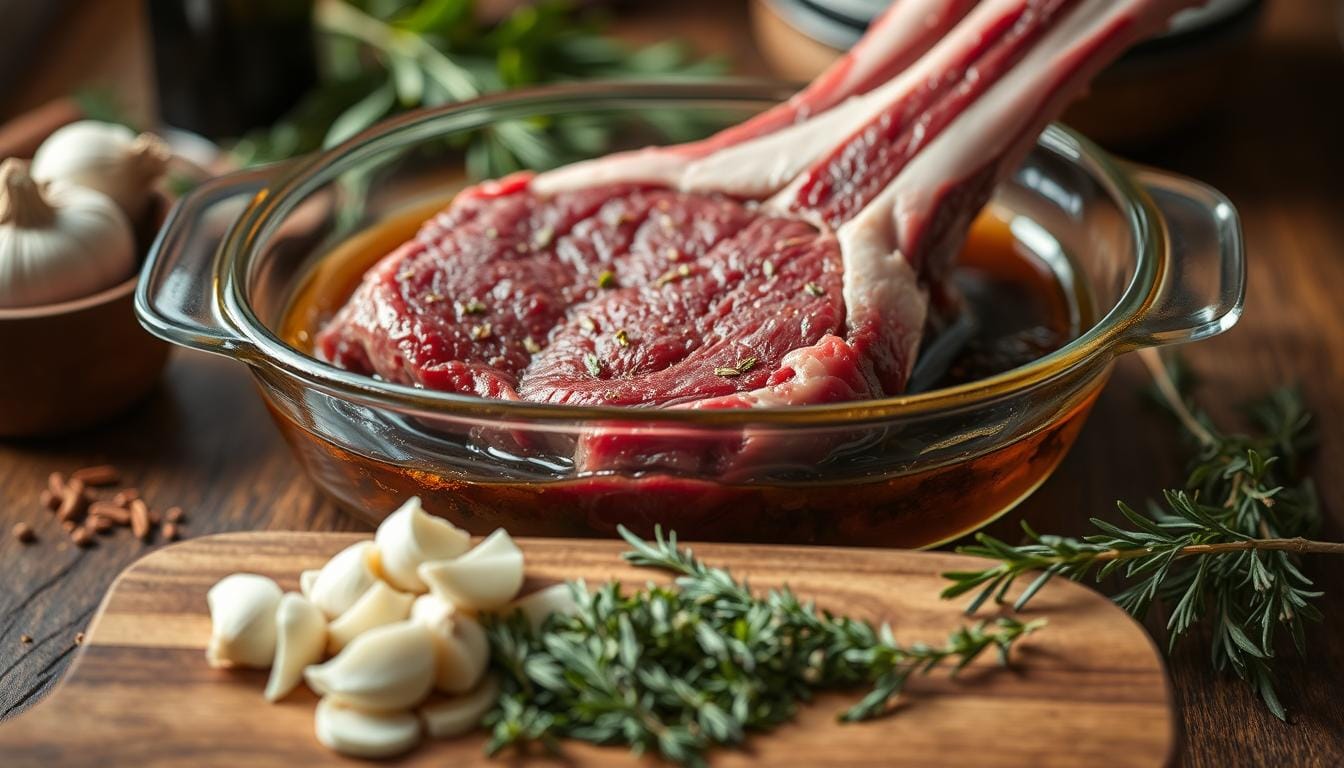Easy Venison Backstrap Marinade for Juicy, Flavorful Meat
Table of Contents
The crisp autumn air and the quiet rustling of leaves always remind me of hunting season. As a passionate outdoor cook, I’ve learned that turning wild game into a delicious meal is an art. This is true, even more so for venison backstrap.
Venison backstrap is a hunter’s favorite cut. It’s known for its tenderness and rich flavor. But it can quickly become dry and tough if not prepared correctly. That’s where a perfect venison backstrap marinade comes in.
Marinating is more than just adding flavor. It’s about making good meat into an amazing dining experience. A well-made venison marinade can soften tough fibers, add deep flavor, and keep your backstrap juicy and tender.
Whether you’re a seasoned hunter or a food lover wanting to try wild game cooking, this guide is for you. You’ll learn how to make your wild game cooking stand out.
Get ready to discover the secrets of making a venison marinade that will delight your taste buds. It will impress even the pickiest of dinner guests.
Understanding Venison Backstrap: The Premium Cut
Venison backstrap is the best part of wild game meat. It’s tender and flavorful, making it perfect for marinades. Hunters and food lovers love it for these reasons.
When making a deer steak marinade, knowing about backstrap is key. It’s lean and tender, needing little processing. It’s found along the deer’s spine.
What Makes Backstrap Special
The backstrap is special for several reasons:
- Located along the deer’s spine
- Minimal muscle movement during the deer’s lifetime
- Exceptionally tender texture
- Low fat content
Backstrap vs. Tenderloin: Key Differences
Many hunters mix up backstrap and tenderloin. But they’re different. Backstrap sits on top of the spine, while tenderloin is underneath. Both are great with marinades, but backstrap is easier to prepare.
Best Cooking Methods for Backstrap
Here are the best ways to cook backstrap:
- Quick searing for medium-rare
- Grilling over high heat
- Oven roasting at controlled temperatures
- Pan-searing with robust marinades
Choosing the right marinade and cooking method makes backstrap unforgettable.
Essential Ingredients for Perfect Venison Backstrap Marinade
Making a great venison marinade is all about the right ingredients. It’s not just a mix of liquids. It’s a special blend that makes the meat tender, juicy, and full of flavor.
For a top-notch venison marinade, you need a few key things:
- Acidic elements: Balsamic vinegar, red wine, or citrus juices break down tough muscle fibers
- Oil base: Olive oil helps distribute flavors and prevents meat from drying out
- Flavor enhancers: Worcestershire sauce, soy sauce, and Dijon mustard add depth
- Aromatics: Fresh garlic, shallots, and herbs like rosemary and thyme
When making your marinade, remember that venison is different from beef. It needs a gentle touch to keep its natural taste. Choose ingredients that enhance its flavor without overpowering it.
Your marinade should have a good balance of acid, oil, and seasonings. Here’s a rough guide:
| Ingredient Type | Recommended Percentage |
|---|---|
| Acid | 30-40% |
| Oil | 40-50% |
| Seasonings | 10-20% |
Try out different mixes to find your ideal venison marinade. Remember, using high-quality ingredients is key to a delicious backstrap.
The Science Behind Marinating Venison
Marinating venison tenderloin is more than a cooking trick. It’s a science that turns tough meat into tender, tasty food. Knowing the chemistry of marinades can make your venison dishes even better.
When you make a venison tenderloin marinade, you’re mixing acids, enzymes, and meat proteins. The right mix can soften muscle fibers. This makes your meat easier to chew and more flavorful.
Role of Acid in Tenderizing
Acids are key in preparing meat. They do several important things:
- Break down protein structures
- Create tiny pockets for flavors
- Make muscle fibers softer
Optimal Marinating Times
How long you marinate your venison tenderloin is very important. Different marinades need different times to work best.
| Meat Thickness | Minimum Time | Maximum Time |
|---|---|---|
| Thin cuts | 30 minutes | 2 hours |
| Thick cuts | 2 hours | 4 hours |
Temperature Considerations
Temperature affects how well your marinade gets into the meat. Always marinate in the fridge at 34-40°F. This keeps bacteria away and lets flavors grow.
Pro tip: Never leave your venison tenderloin marinade at room temperature for more than 30 minutes to ensure food safety.
Step-by-Step Marinade Preparation Process
Making the perfect venison backstrap marinade needs focus and a plan. Your marinade can turn a simple cut of meat into a memorable dish.
First, collect all your marinade ingredients. Have a clean bowl or jar ready to mix everything together.
- Choose a non-reactive container (glass or ceramic)
- Measure ingredients precisely
- Whisk ingredients until fully combined
When making your marinade, aim for a mix of flavors. Acidic ingredients like vinegar or citrus juice tenderize the meat and add flavor.
- Mix the liquid ingredients first
- Add herbs and spices
- Incorporate oil to help distribute flavors
Put your marinade into a zip-lock bag or sealed container. Place the meat inside, making sure it’s fully covered. Pro tip: Massage the marinade gently into the meat for maximum flavor absorption.
Always marinate in the refrigerator to prevent bacterial growth and maintain food safety.
Put the marinating venison backstrap in the fridge for 2-8 hours. This lets the flavors soak in without damaging the meat.
Best Cooking Techniques for Marinated Backstrap
Preparing a deer steak in the oven needs skill and precision. The right cooking method can make your venison backstrap tender and delicious. This ensures your meal showcases the meat’s natural flavors.
Choosing the right cooking method is key. It depends on what you like, what you have, and how you want it cooked.
Grilling the Perfect Backstrap
Grilling venison needs high heat and careful watching. Here are some tips to help:
- Preheat grill to high temperature (around 450°F)
- Ensure grill grates are clean and oiled
- Cook 3-4 minutes per side for medium-rare
- Use tongs to avoid piercing the meat
Mastering Deer Steak in Oven
Oven roasting cooks your backstrap evenly. Here’s a simple way to do it:
- Preheat oven to 425°F
- Use a cast-iron skillet or roasting pan
- Sear meat for 2-3 minutes on each side
- Transfer to the oven for 10-15 minutes
- Check the internal temperature reaches 135°F for medium-rare
Pan-Searing Technique
If you can’t grill, pan-searing is a great alternative. Cast-iron skillets are best for a perfect crust.
- Heat the skillet until smoking hot
- Add a small amount of high-smoke-point oil
- Sear each side for 2-3 minutes
- Rest the meat for 5-7 minutes before slicing
Remember, venison is lean and can get tough if overcooked. Cook it to medium-rare to keep it tender and flavorful.
Temperature Guidelines and Cooking Times

Cooking venison backstrap needs precision for the best results. Knowing the internal temperatures is key. It helps achieve the perfect doneness without losing the meat’s flavor and texture.
When making your deer steak marinade, use a meat thermometer. It’s important for tracking the internal temperature. Different doneness levels need specific temperature ranges:
- Rare: 110-115°F
- Medium-Rare: 115-125°F (Recommended)
- Medium: 130-135°F
- Medium-Well: 140-145°F
- Well-Done: 150°F and above
Your deer steak marinade will make the meat tender. But, controlling the temperature is key. Take the backstrap off the heat a bit before your desired temperature. This is because the temperature will rise a bit more while it rests.
| Doneness Level | Internal Temperature | Resting Time |
|---|---|---|
| Rare | 110-115°F | 5-7 minutes |
| Medium-Rare | 115-125°F | 8-10 minutes |
| Medium | 130-135°F | 10-12 minutes |
Venison is lean, so watch the temperature closely. This prevents overcooking and keeps the meat tender and delicious. A good deer steak marinade and careful temperature control make for a great meal.
Tips for Achieving Maximum Tenderness and Flavor
Preparing venison tenderloin marinade needs careful attention for the best taste. How you handle the meat greatly affects the dish’s flavor and texture.
Mastering venison backstrap preparation involves key steps. These steps can make your dish stand out:
Meat Preparation Essentials
- Remove any visible silver skin or tough connective tissue before marinating
- Pat the venison tenderloin dry with paper towels to ensure better marinade absorption
- Trim excess fat, leaving a thin layer for enhanced flavor
- Use a sharp knife to create uniform thickness for even cooking
Strategic Temperature Management
Temperature is key in preparing your venison tenderloin marinade. Always allow the meat to rest at room temperature for 30-45 minutes before cooking. This ensures even cooking and prevents tough meat.
“The secret to tender venison is patience and precision in preparation.” – Wild Game Chef
Resting and Slicing Techniques
After cooking your marinated venison backstrap, follow these critical resting and slicing guidelines:
- Let the meat rest for 10-15 minutes after cooking
- Cover the meat loosely with aluminum foil during resting
- Slice against the grain using a sharp knife
- Cut thin, uniform slices to maximize tenderness
By using these techniques, you’ll turn your venison tenderloin marinade into a delicious dish. It will impress everyone with its rich, wild game flavor.
Common Mistakes to Avoid When Marinating Venison

Preparing a venison marinade needs precision and care. Many home cooks make mistakes that can ruin the quality of their wild game meat. Knowing these common errors will help you make a delicious venison backstrap every time.
- Over-Marinating: One big mistake is leaving meat in the liquid too long. Venison is lean and delicate. Acidic marinades can quickly break down the protein structure.
- Incorrect Salt Levels: Too much salt can draw out moisture, making the meat tough and dry.
- Improper Storage: Marinating at room temperature or in the wrong container can lead to bacterial growth and food safety risks.
Your venison marinade technique should aim for balanced flavors and the right timing. Most marinades work best for 4-8 hours, depending on the meat’s thickness and your ingredients.
| Mistake | Consequence | Solution |
|---|---|---|
| Over-Marinating | Mushy Texture | Limit marinade time to 8 hours maximum |
| Insufficient Drying | Poor Searing | Pat meat completely dry before cooking |
| Wrong Container | Metallic Taste | Use glass or food-safe plastic containers |
Professional chefs suggest using non-reactive containers and keeping your venison marinade refrigerated. Always remove the meat from the marinade, letting excess liquid drip off before cooking. This ensures a perfect sear and keeps those delicious flavors locked in.
Conclusion
Learning how to make a great venison backstrap marinade can turn a simple meal into a special treat. It’s all about finding the right mix of ingredients and cooking methods. This way, you can make a dish that’s as good as the best beef tenderloin.
Your marinade does more than just add flavor. It also makes the meat tender and keeps its natural taste. Every step you take, from picking the right acids to controlling the heat, helps make a meal that’s both tasty and memorable. Being patient and careful is key when cooking this special cut.
Try out different marinades and cooking ways to find your own style. Whether you grill, roast in the oven, or pan-fry, the basics stay the same. Your venison backstrap can become a dish that wows everyone, showing off your cooking talent and love for game meat.
We encourage you to try these techniques in your kitchen. Start with the recipes and ideas from this guide. Then, feel free to get creative. Your perfect venison backstrap marinade is just around the corner.
FAQ
What is venison backstrap and why is it considered a premium cut?
How long should I marinate venison backstrap?
What are the best cooking methods for venison backstrap?
Can I substitute ingredients in a venison backstrap marinade?
How do I prevent venison backstrap from becoming tough?
What are some common marinades for venison backstrap?
Can I freeze marinated venison backstrap?
What internal temperature should venison backstrap be cooked to?
Did You Try Our Recipe?
There are no reviews yet. Be the first one to write one.

